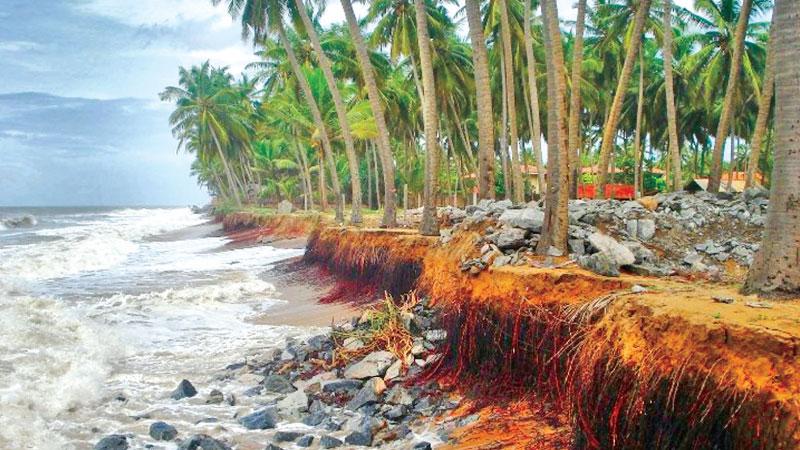
Sri Lanka is a picturesque island with a 1,620 kilometre long coastline where there are numerous heritage sites, restaurants, hotels and business establishments catering to tourists.
This coastal belt around the country is also blessed with lagoons, estuaries, bays, sand dunes, sea grasses, salt marshes, mangroves, sandy beaches, coral reefs and beach mineral resources.
The coastal zone of Sri Lanka with all these resources immensely contributes to the sustainable development of the country.
However, the erosion of the coastal zone due to natural phenomena and anthropogenic influences for years on end has been identified as a longstanding problem which has had an adverse negative impact on the lives of the people along the coastline.
This also causes long-term adverse economic consequences as a result of tourist attractions being washed away by the sea.
Ravaging sea waves have considerably eroded the South-Western, Western and North- Western coastlines of Sri Lanka.
Residents in areas such as the Negombo- Pitipana coastal belt in Morawala, Iranawila and Udappuwa in Puttalam, Calido beach in Kalutara and the coastal belt in Mount Lavinia, Dehiwala and Ratmalana have been severely affected by this environmental phenomenon.
The picture of the Iranawila coastline clearly shows the gravity of this coastal erosion and environmental degradation caused by encroaching sea waves particularly during storms under the South- Western monsoon period.
Fishermen in Iranawila, Chilaw complain that they have been severely affected by the sea erosion which is incessantly occurring in the area.
Nearly 100 families in the area have lost their houses as a result of their lands being inundated by sea water that swept in and also many business establishments including prawn hatcheries have been washed away by the sea.
It is the coastline that is located to the North of the Thoduwawa estuary that sea erosion is most severe. For the past couple of years, more than two kilometres of this shoreline have been eroded by the sea. In addition, two houses there were destroyed and many more houses and coconut trees are on the brink of being razed to the ground by breaking sea waves.
Successive Governments made efforts and spent a whopping sum of money on many projects to minimise sea erosion but this problem still remains unsolved. Rocks placed along the beach of some affected areas have also been swept into the sea.
Residents in the area said that the carpet road from Chilaw to Wennappuwa is also in danger of being washed out to sea.
When the Chief Engineer of the Department Sakuntha Padmasiri was contacted, he said that several projects have already been designed and money has been allocated to complete them.
The construction of a 200 metre-long rock revetment to the North of the Udappuwa Bridge and another 160 metre- long rock revetment in Iranawila are some of those plans of work to be put into action this year.
Due to the South - West monsoon from May to September, Sri Lanka’s Southern coastline, Western coastline and North Western coastline face the danger of sea erosion whereas from November to February, as a result of the North- East monsoon, the Eastern coastline begins to be affected by coastal erosion, he said.
